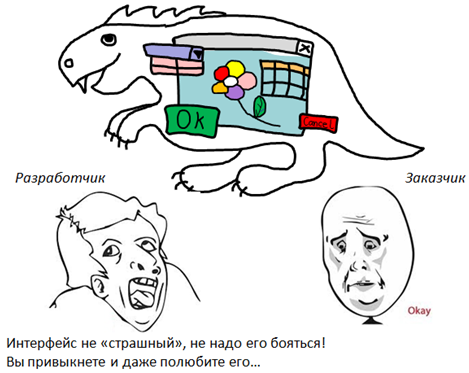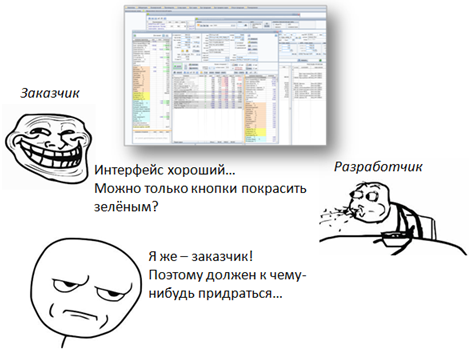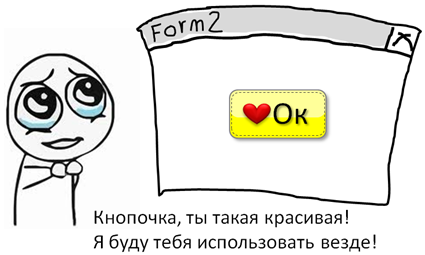Why do Delphi make bad interfaces?
One often hears: “Delphi is a medium for developing“ curved ”interfaces. Or Delphi-developers are genetically flawed in terms of creating interfaces. Or the environment itself provokes a bad GUI design. There is a reason to focus on this issue.
At the beginning of the "era of the applied boom" through the use of visual development tools dominated by Delphi. Of course, there were other application development tools with a window interface (Visual Basic, Visual Studio, etc.), but, recalling the situation in Russia in the Delphi 1 ... 3 period, one can reasonably say that this environment is widespread. The product "shot", primarily because of the huge shortage of software. But the language simplicity of Delphi played a key role - there were a lot of engineers, but few programmers. But in Delphi, people after the institute course for a month could, if not become programmers, then at least developers. In a sense, could independently create software products.
')
Delphi, along with uncomplicated skills of creating a window interface has become for many a ticket to IT life. People learned to create software, guided by their own ideas about what should be a GUI. The situation was complicated by the fact that there were no interface design rules. In the pre-Delphic Borland C ++ 4.x, the template for the dialog box implied a vertical arrangement of the [Ok] [Cancel] buttons on the right. In Delphi it was possible to place the buttons as you like. Can this be considered a provocation? Exactly as much as “freedom” in general and “flexibility” in the field of software development tools is considered as such.
So, at the entrance we have a significant number of developers whose qualifications were determined by the time for self-preparation. The training took place "along the way" and at the expense of "own resources". It is quite natural that the first applications struck by the diversity of their interface forms. If, instead of Delphi, there was a different technology, then it would be used for mass self-learning with predictable consequences. If the teacher of the Russian language at school complains that “the students do not know Russian at all and write with monstrous errors”, then the matter is not in the Russian language. English (Chinese, Japanese, Czech) schoolchildren give out no less amusing “pearls”, learning to formulate their thoughts within the free framework of the grammar and stylistics of a natural language.

Conclusion (evolutionary): in Delphi, because of its “primacy” as a software development technology, a lot of not very outstanding interfaces have been made. But the problem is not in Delphi, but in the natural course of history.
Further, in the “early Delphic period” almost any application software created was unique (in terms of the lack of analogues). The more effective the project was, the more chances it was to re-stabilize, freezing the original, if not optimal, GUI layout. Therefore, the existence of successful software with a "curved" interface is a sign of success!
Conclusion (paradoxical): the more successful a bad-gui project, the less likely it is to make it better. And success is achieved due to many factors, not necessarily related to the quality of the graphical interface.

Of course ... If in Delphi everyone used MVC or some other technique of separating the interface from the algorithm and logic ... But these hopes are unjustified. They kind of promise us an “easy replacement” of the interface. Only now the interface grows with functionality, sometimes overtaking it, sometimes catching up. Changing the interface - this is not a car repaint, this body change.
How many times have we heard from users: “Where are you doing my button? She was “crooked,” but I was used to it. And where should I look for it now? ”At a minimum, this fixes not the most beautiful solutions, and in the most difficult cases, you have to“ continue to throw buttons on the form, ”since required by the end user.
Conclusion (disappointing): The quality of the user interface may decrease (not increase) due to user requirements! User habits - brake shoe in the way of an armored train of revolutionary interface improvements.
Programmers are creative people. The main driver for the development of all technologies is the desire to do better. The functional is in function, the procedural code is in classes, the classes are generalized by templates (“generics” in Delphi). No one wants to perform monotonous routine operations and make boring interfaces. “The customer wants me to write a second Ehel!” - this is one of the main problems of that initial period, when the user was guided in his preferences for products from the MS Office. But the developer managed, at times, to push through his "installations".

Conclusion (creative): Too original interfaces are not a sign of a lack of taste / knowledge. This is a side effect of the desire for self-expression inherent in programmers.
Boys can't dance / draw. Rejecting all sexism, however, we must recognize that software development is largely the responsibility of the strong half of humanity. Many make interfaces "ugly, but monotonous" (army joke). Whether delphists are more “masculine” than users of other development tools is not known. There was a case in my practice (development on a theme for a power state structure) when a demand was made - the interface should be green (in the literal sense)! The armored car is green, the onboard laptop is green, the interface must also be green! Can I just change the color scheme of Windows to green? Not! And so that all the buttons were “square-nested”, as on the control panel.

Conclusion (characterless): the "curvature" of the interface is often determined by the tastes of users. What users, such and tastes. And where does Delphi? Given that the "delphist" is appeasable and uncomfortable due to the visuality of the development environment. Want 3 pixels left? You are welcome!
Windows as an operating system is conservative in terms of the interface of application programs. From Windows 95 to Windows 7, except for “Ribbon” (and even how to look at this phenomenon) did not offer any special innovations (but Windows 8 more than compensated for years the accumulated need for innovations). In the design based on "classic components" there was no field for seeking competitive advantages. The leading players began to "sand" the interfaces, they had enough taste, talent and resources for inviting professionals from the outside. Prikladniki began to resemble them, only the rich lion's skin was replaced by a quilt made from the skins of assorted rabbits.

General conclusion: when we look at another product with a user interface, striking in its wildness, we need to understand the degree of influence of Delphi as a tool on the final design. Driving on the roads of our country and nervous about the “bad driving culture”, “dangerous driving” and “unintentionally creating emergency situations” by the participants of the movement, we do not blame car manufacturers!
Coming soon Delphi mobile apps for Android will end. There will be an excellent material for generalizing the technique of using the “Platform FM” to create “mobile interfaces”. Over 300 applications filed.

All with friday!
There are still 12 days before the end of the competition, there are developers who have already submitted their completed projects for consideration. For the time being, both new and old “delphists” demonstrate a subtle sense of the specifics of mobile interfaces for Android. We are looking forward to summarizing.

At the beginning of the "era of the applied boom" through the use of visual development tools dominated by Delphi. Of course, there were other application development tools with a window interface (Visual Basic, Visual Studio, etc.), but, recalling the situation in Russia in the Delphi 1 ... 3 period, one can reasonably say that this environment is widespread. The product "shot", primarily because of the huge shortage of software. But the language simplicity of Delphi played a key role - there were a lot of engineers, but few programmers. But in Delphi, people after the institute course for a month could, if not become programmers, then at least developers. In a sense, could independently create software products.
')
Delphi, along with uncomplicated skills of creating a window interface has become for many a ticket to IT life. People learned to create software, guided by their own ideas about what should be a GUI. The situation was complicated by the fact that there were no interface design rules. In the pre-Delphic Borland C ++ 4.x, the template for the dialog box implied a vertical arrangement of the [Ok] [Cancel] buttons on the right. In Delphi it was possible to place the buttons as you like. Can this be considered a provocation? Exactly as much as “freedom” in general and “flexibility” in the field of software development tools is considered as such.
So, at the entrance we have a significant number of developers whose qualifications were determined by the time for self-preparation. The training took place "along the way" and at the expense of "own resources". It is quite natural that the first applications struck by the diversity of their interface forms. If, instead of Delphi, there was a different technology, then it would be used for mass self-learning with predictable consequences. If the teacher of the Russian language at school complains that “the students do not know Russian at all and write with monstrous errors”, then the matter is not in the Russian language. English (Chinese, Japanese, Czech) schoolchildren give out no less amusing “pearls”, learning to formulate their thoughts within the free framework of the grammar and stylistics of a natural language.

Conclusion (evolutionary): in Delphi, because of its “primacy” as a software development technology, a lot of not very outstanding interfaces have been made. But the problem is not in Delphi, but in the natural course of history.
Further, in the “early Delphic period” almost any application software created was unique (in terms of the lack of analogues). The more effective the project was, the more chances it was to re-stabilize, freezing the original, if not optimal, GUI layout. Therefore, the existence of successful software with a "curved" interface is a sign of success!
Conclusion (paradoxical): the more successful a bad-gui project, the less likely it is to make it better. And success is achieved due to many factors, not necessarily related to the quality of the graphical interface.

Of course ... If in Delphi everyone used MVC or some other technique of separating the interface from the algorithm and logic ... But these hopes are unjustified. They kind of promise us an “easy replacement” of the interface. Only now the interface grows with functionality, sometimes overtaking it, sometimes catching up. Changing the interface - this is not a car repaint, this body change.
How many times have we heard from users: “Where are you doing my button? She was “crooked,” but I was used to it. And where should I look for it now? ”At a minimum, this fixes not the most beautiful solutions, and in the most difficult cases, you have to“ continue to throw buttons on the form, ”since required by the end user.
Conclusion (disappointing): The quality of the user interface may decrease (not increase) due to user requirements! User habits - brake shoe in the way of an armored train of revolutionary interface improvements.
Programmers are creative people. The main driver for the development of all technologies is the desire to do better. The functional is in function, the procedural code is in classes, the classes are generalized by templates (“generics” in Delphi). No one wants to perform monotonous routine operations and make boring interfaces. “The customer wants me to write a second Ehel!” - this is one of the main problems of that initial period, when the user was guided in his preferences for products from the MS Office. But the developer managed, at times, to push through his "installations".

Conclusion (creative): Too original interfaces are not a sign of a lack of taste / knowledge. This is a side effect of the desire for self-expression inherent in programmers.
Boys can't dance / draw. Rejecting all sexism, however, we must recognize that software development is largely the responsibility of the strong half of humanity. Many make interfaces "ugly, but monotonous" (army joke). Whether delphists are more “masculine” than users of other development tools is not known. There was a case in my practice (development on a theme for a power state structure) when a demand was made - the interface should be green (in the literal sense)! The armored car is green, the onboard laptop is green, the interface must also be green! Can I just change the color scheme of Windows to green? Not! And so that all the buttons were “square-nested”, as on the control panel.

Conclusion (characterless): the "curvature" of the interface is often determined by the tastes of users. What users, such and tastes. And where does Delphi? Given that the "delphist" is appeasable and uncomfortable due to the visuality of the development environment. Want 3 pixels left? You are welcome!
Windows as an operating system is conservative in terms of the interface of application programs. From Windows 95 to Windows 7, except for “Ribbon” (and even how to look at this phenomenon) did not offer any special innovations (but Windows 8 more than compensated for years the accumulated need for innovations). In the design based on "classic components" there was no field for seeking competitive advantages. The leading players began to "sand" the interfaces, they had enough taste, talent and resources for inviting professionals from the outside. Prikladniki began to resemble them, only the rich lion's skin was replaced by a quilt made from the skins of assorted rabbits.

General conclusion: when we look at another product with a user interface, striking in its wildness, we need to understand the degree of influence of Delphi as a tool on the final design. Driving on the roads of our country and nervous about the “bad driving culture”, “dangerous driving” and “unintentionally creating emergency situations” by the participants of the movement, we do not blame car manufacturers!
Coming soon Delphi mobile apps for Android will end. There will be an excellent material for generalizing the technique of using the “Platform FM” to create “mobile interfaces”. Over 300 applications filed.

All with friday!
There are still 12 days before the end of the competition, there are developers who have already submitted their completed projects for consideration. For the time being, both new and old “delphists” demonstrate a subtle sense of the specifics of mobile interfaces for Android. We are looking forward to summarizing.

Source: https://habr.com/ru/post/205954/
All Articles